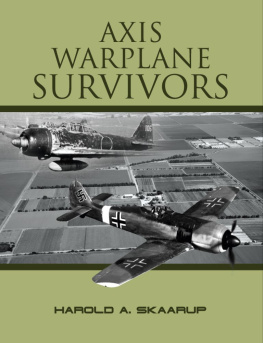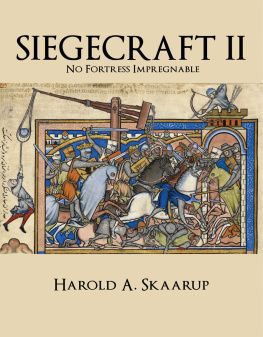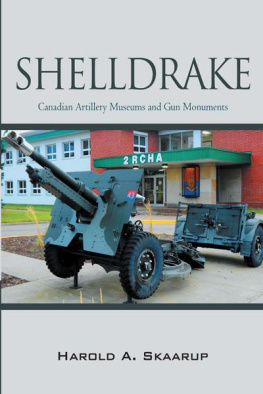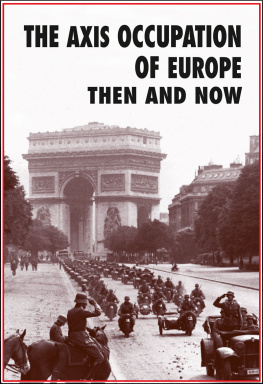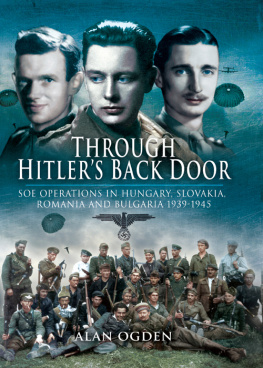Axis Warplane Survivors
Preserved Military Aircraft of the Second World War Tripartite Pact of Germany, Italy, and Japan, joined by Hungary, Romania, Slovakia, Bulgaria, and Yugoslavia; the co-belligerent states of Thailand, Finland, San Marino and Iraq; and the occupied states of Albania, Belarus, Croatia, Vichy France, Greece, Ljubljana, Macedonia, Monaco, Montenegro, Norway, Cambodia, China, India, Laos, Manchukuo, Mengjiang, the Philippines and Vietnam
Copyright 2012 by Harold A. Skaarup
All Rights Reserved. No part of this book may be reproduced or transmitted in any form or by any means, graphic, electronic, or mechanical, including photocopying, recording, taping or by any information storage or retrieval system, without the written permission of the publisher except in the case of brief quotations embodied in critical articles and reviews.
Because of the dynamic nature of the Internet, any Web addresses or links contained in this book may have changed since publication and may no longer be valid.
The views expressed in this work are solely those of the author and do not necessarily reflect the views of the publisher, and the publisher hereby disclaims any responsibility for them.
This handbook is intended to be used a reference source of information on where to find surviving Axis Warplanes. The data will constantly change as more of the missing warplanes are found, and therefore it can only be as current as the date of publication. Corrections, additions and updates of new finds and information concerning Axis military aircraft restoration projects would be most welcome.
ISBN: 978-1-6175-0818-9
Dedication
This book is dedicated to the men and women of the Royal Canadian Air Force and the members of the Canadian Forces Intelligence Branch who have been engaged in Air Technical Intelligence and the evaluation of captured military aircraft, past and present. Good ideas, no matter the source, can always be used to enhance the future of aviation.
Sic itur ad Astra
E Tenebris Lux
War Prize Mystery
During the research into the locations of surviving Second World War Prize equipment brought to Canada in 1945, the author spoke with retired Captain and author Farley M. Mowat about his post war task of collecting German equipment that was of interest to Canada. He was very detailed in his response, and in one incident of note he mentioned that in the spring of 1945 he spoke with the leader of the Dutch resistance in his area, Colonel Tyc Michaels, who informed him of the location of the Rheintochter anti-aircraft missile factory, which had been bombed out. His team investigated and collected some documentation and a few parts that made it back to Canada. During this investigation, his Intelligence Collection Team learned of a trainload of ten V-2 rockets which were sitting on railway cars in a railway siding hidden in the Black Forest in Southwest Germany. He dispatched Lieutenant Mike Donovan, a Canadian Intelligence Corps Officer, to see if he could acquire one of these V-2s from the British who occupied the sector.
Lieutenant Donovan set out from the teams home base at Meppen in the Netherlands and drove to the Black Forest with a 12-ton Mack breakdown lorry with a tow-hook hauling a German mini-submarine trailer and visited the site to see what could be arranged. The British were not keen on parting with such important war material to colonials, but Lieutenant Donovan had brought along a case of booze for the occasion, and proceeded to get the British Infantry guard group drunk. While this was taking place, other members of his team crept over to the railway siding and stealthily managed to break the chains and roll one of the V-2s off of its railway flatcar and onto the German mini-sub trailer. (This could not have been an easy task in the dark, as the rocket is the size of a modern day SCUD similar to those the author examined near Policharki, Afghanistan). Hiving off at the high port, so to speak, Lieutenant Donovan and his crew barrelled back the way they came and delivered the rocket to the dockside near Meppen in Holland.
In order to keep the collected war prize concealed, Captain Mowat had carpenters build a small wooden conning tower, which they installed on top of the rocket. Once the mock tower was in place, the team quickly proceeded to paint the complete V-2 rocket in navy blue. Curious inquirers were told that the device was an experimental submarine. In this form, the V-2 was loaded on the Liberty Transport Ship SS Blommersdyke and quickly left port with the other 700 tons of collected German war prizes and steamed across the Atlantic to Montreal. On arrival, Captain Mowat spoke with the Chief of General Staff (GGS), Major-General Howard Graham, an officer he had served with in the Hastings and Prince Edward Regiment, to explain in detail what they had imported. Shortly afterwards, a Lieutenant-Colonel arrived from the Defence Research Establishment at Valcartier, Quebec, and a work crew which hauled the V-2, trailer and all, back to Valcartier. There, the V-2 was dismantled. As the science team was examining the rocket they made the interesting, if somewhat disconcerting discovery that the warhead was still filled with its high explosive material. The liquid explosive compound inside the rockets warhead had hardened and had to be removed by the scientists by carefully drilling a hole in the nose cone and inserting a hose to wash it out.
The V-2 was blueprinted and then disappeared from the story for a few years. In 1950 it was placed on display on the grounds of the Canadian National Exhibition in Toronto (see photo at
The author would be very interested in hearing from any reader who may have information that could lead to the discovery of where this V-2 is presently located.
Major (Retired) Harold A. Skaarup
Fredericton, New Brunswick
8 August 2012
www.SilverHawkAuthor.com
Table of Contents
List of Illustrations
| Focke-Wulf Fw 190A-3, MP499; & Arado Ar 234B1, AM26. |
| Avro 683 Lancaster, BQ-B; Junkers Ju 352A-0, AM8, VP550; & Focke-Wulf Fw 200C-4/U1, AM94. |
| Siebel Si 204D, six views. |
| Messerschmitt Bf 108; Junkers Ju 290A-7, AM6; & Arado Ar 232B-0, AM17. |
| Messerschmitt Bf 110G-4/R6, AM34; Heinkel He 219A-2, AM21; & Junkers Ju 188A-2, AM113. |
| Ju 388L-1/V-6 Stortebecker, AM83; Dornier Do 335A-12 Pfeil, AM223; & Dornier Do 335A-1, AM225. |
| Messerschmitt Me 410A-1, AM72; Arado Ar 96B, AM120; & Gloster Meteor F Mk. IV in flight. |
| Blackburn Firebrand F Mk. IV in flight; Focke-Wulf Fw 200C-4/U1, AM94; & Arado Ar 196A- 5, AM92. |
| Junkers Ju 52/3m, AM104; Messerschmitt Bf 110G-4/R6, AM34; & Focke-Wulf Ta 152H-1, AM11. |
| Farnborough Airshow static display 1945; Heinkel He 162A-2, AM62, post war in Hyde Park, September 1945; & Blhm und Voss Bv 155B (V-2) partially sectioned, Farnborough, November 1945. |
| DFS 228 V1 with Dornier Do 217K V-3 carrier aircraft; Heinkel He 162A-2; & Messerschmitt Me 163B-1a, VF241. |
| Messerschmitt Me 410A-3 wreck on the banks of the Sangro River, Italy. |
| Heinkel He 111H-1, AW177 in flight; Messerschmitt Bf 109E-1, AE479 in flight; & Junkers Ju 88A-6, HM509 in flight. |
| Captured Fiat CR.42, ex-MMN.5701, BT474 in RAF markings at the Air Fighting Development Unit, Duxford, 1941, in flight and on the ground; & Gotha Go 145 biplane at Celle airport being inspected by British troops. |
Next page
